Imagine stepping outside to a thriving green oasis that produces fresh food year after year without exhausting your resources. By organizing your planting areas thoughtfully, you’ll create a system where every season builds on the last. This approach keeps your earth nutrient-rich while naturally discouraging pests.
Successful growers don’t leave things to chance. Instead of randomly placing seeds, they follow proven patterns that maximize yields and minimize effort. You’ll learn how simple adjustments—like grouping compatible plants or rotating crops—can prevent disease and boost growth.
Think of your plot as a living ecosystem. When tomatoes move to where spinach grew last year, they access fresh nutrients while breaking pest cycles. For more seasonal care tips, explore how compost blends and smart layouts keep beds productive across all weather conditions.
This method isn’t just about bigger harvests—it’s about working smarter. You’ll spend less time battling weeds and more enjoying crisp vegetables. Whether you nurture a compact 4×4-foot bed or larger plots, these principles adapt effortlessly to your space.
Ready to turn guesswork into confidence? Let’s build a foundation where every planting decision supports long-term vitality. Your future self will thank you when harvests grow richer while maintenance shrinks.
Overview of Seasonal Crop Rotation
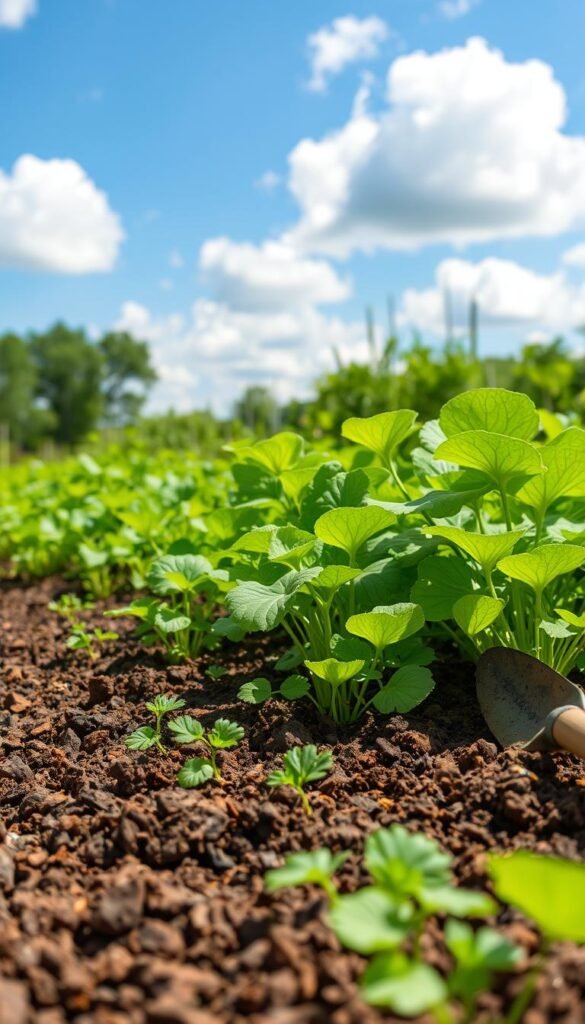
Growing different plants in the same spot each year keeps your earth lively and productive. This practice balances what’s taken from the ground while disrupting unwanted visitors lurking below. Let’s explore how smart planting patterns protect your plot naturally.
Understanding Soil Nutrient Management
Plants have unique appetites. Leafy greens crave nitrogen, while root vegetables need more phosphorus. Rotating plant families prevents any single nutrient from draining completely. For example, following heavy feeders like corn with nitrogen-fixing beans replenishes the earth.
Here’s how common plant groups affect soil composition:
| Plant Family | Nutrient Focus | Rotation Benefit |
|---|---|---|
| Legumes | Adds nitrogen | Prepares soil for leafy crops |
| Brassicas | Needs high nitrogen | Follows legumes well |
| Nightshades | Uses phosphorus | Precedes root vegetables |
Minimizing Pests and Disease Risks
Insects and fungi often target specific plants. By moving their favorite snacks yearly, you break their life cycles. A four-zone rotation system makes this easy—divide your space into sections and shift crops clockwise annually.
Most harmful organisms can’t survive three seasons without their preferred host. This natural defense works better than sprays, keeping your food chemical-free. Combine rotation with compost for soil that grows stronger each season.
Why Garden Planning Matters for a Healthy Garden
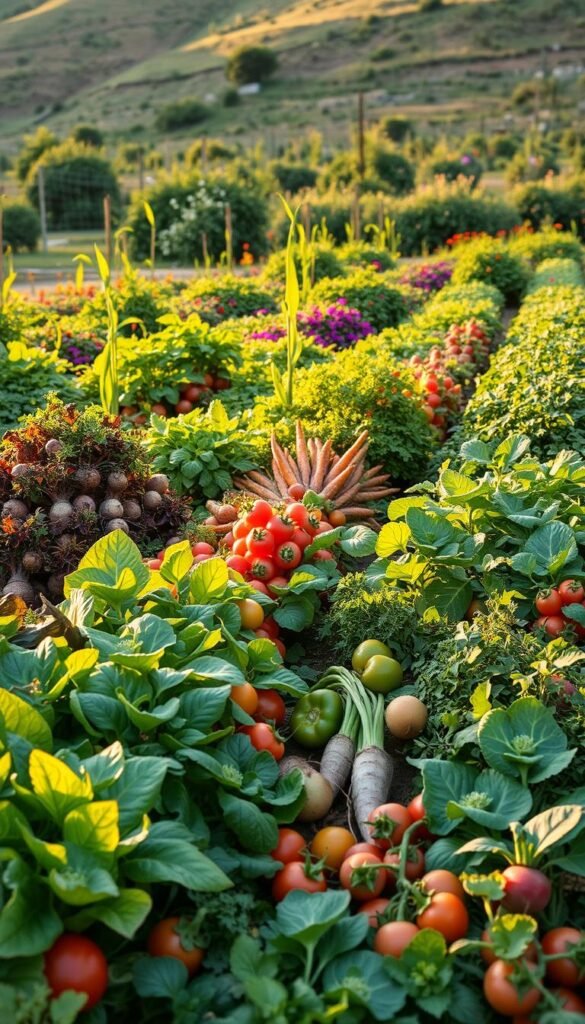
A thriving plot isn’t just about what you grow—it’s about how you arrange it. Mixing various species creates a living network where roots, microbes, and insects collaborate to strengthen your green space naturally.
The Power of Plant Variety
Different species act like puzzle pieces that protect each other. Leafy neighbors might shade soil to retain moisture, while flowering herbs attract pollinators that deter destructive bugs. This teamwork reduces the need for chemical fixes.
Monoculture setups—like endless rows of tomatoes—invite trouble. Pests establish colonies quickly when their favorite meal stays put year after year. Rotating vegetables and blending plant families breaks this cycle. “Diversity is nature’s insurance policy,” as seasoned growers say.
Healthy soil thrives when plants have varied nutrient needs. Deep-rooted varieties mine minerals from sublayers, while shallow-rooted types recycle surface nutrients. Pairing heavy feeders with light users prevents depletion—a key strategy in strategic layout planning.
Beneficial insects also flourish in mixed plantings. Ladybugs patrol broccoli when nearby dill provides shelter. These allies tackle aphids more effectively than any spray, creating self-sustaining defenses.
By imitating natural ecosystems, you build resilience against droughts, diseases, and pests. Each season’s harvest becomes more robust as your green space learns to balance itself—proof that smart design outworks constant intervention.
Garden Planning Made Simple: Seasonal Crop Rotation and Scheduling
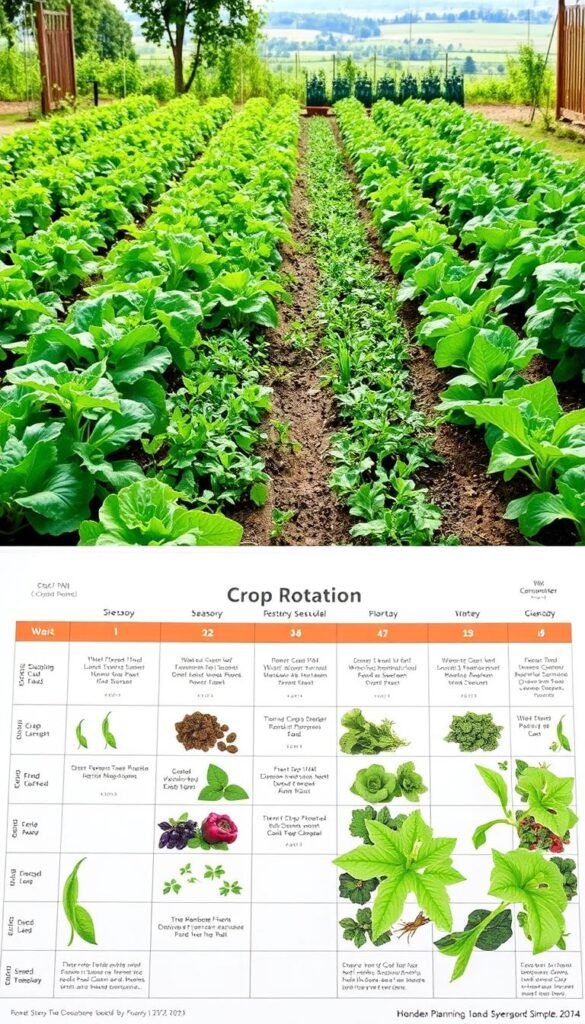
Transform your growing space with a structured approach that works like nature’s own rhythm. Let’s break down a straightforward method to keep your earth thriving while boosting productivity.
A Step-by-Step Rotation Guide
Start with a three-year cycle that balances plant needs and soil health. Heavy feeders like tomatoes and peppers kick things off, using nutrients stored from previous seasons. Follow them with cabbage-family plants that need fewer resources. Finish with peas and beans—nature’s fertilizer factories.
| Year | Plant Type | Key Crops | Soil Impact |
|---|---|---|---|
| 1 | Heavy Feeders | Tomatoes, Peppers | Use existing nutrients |
| 2 | Moderate Feeders | Cabbage, Kale | Preserve soil balance |
| 3 | Soil Builders | Peas, Beans | Add nitrogen |
Track your plantings using a rotation calendar to stay organized. Shift crops clockwise each spring—this simple pattern prevents disease buildup and keeps pests guessing.
Long-Term Benefits for Your Garden
Over time, this system creates richer earth and bigger harvests. Jack Algiere from Stone Barns Center notes: “Consistent rotation cuts pest problems by half while improving yields.” Legumes replenish nitrogen naturally, setting the stage for next year’s tomatoes to thrive.
You’ll notice fewer sick plants and less weeding as the years pass. Studies show corn yields jump 29% when rotated properly. Your space becomes self-sustaining—healthier soil means happier plants with minimal effort from you.
Mapping Your Garden Layout for Year-Round Success
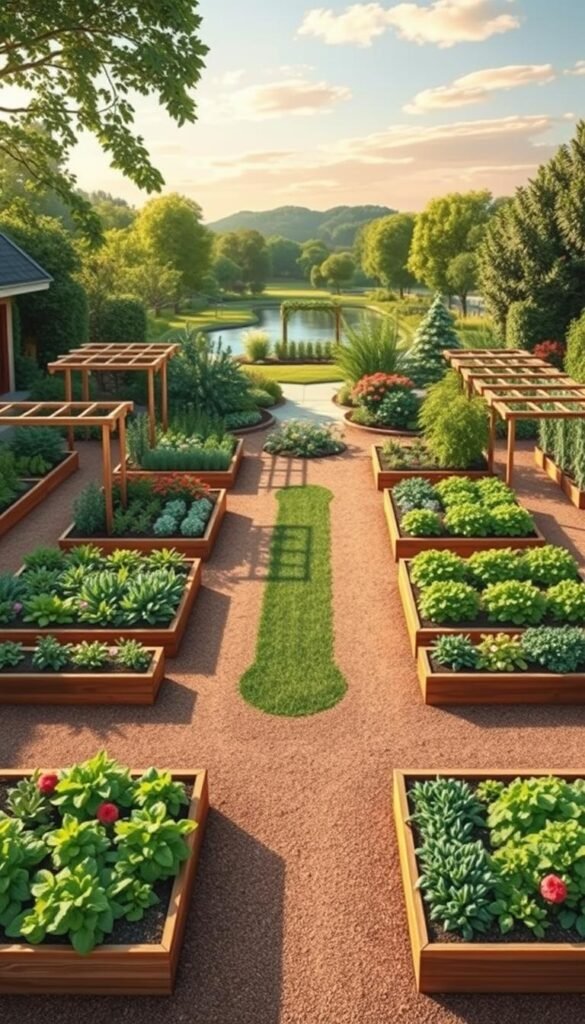
Visual organization transforms chaos into abundance. A well-mapped plot acts like a treasure map—it shows exactly where each plant thrives while preventing overcrowding. Start by sketching every inch of your growing area, from permanent structures to movable pots.
Using Grid Paper and Garden Maps
Grab graph paper to scale your space accurately. Measure existing beds, pathways, and container locations first. Mark perennial crops like strawberries with bold outlines—they’ll stay put for years.
Leave 24-inch walkways between in-ground rows. For raised beds, allow 3-foot gaps. This prevents trampling while letting air circulate. Overwintered garlic needs clear labeling since it occupies space until midsummer.
Designing for Multiple Growing Zones
Treat vertical planters and grow bags as essential parts of your plan. Position them where they’ll get sunlight without shading other vegetable plants. Cluster herbs in window boxes near kitchen doors for easy access.
Measure twice, plant once. Use colored pencils to differentiate annuals from perennials. Update maps each season—garlic beds become perfect spots for quick-growing greens after July harvests.
Flexibility matters. Leave blank squares for surprise seedlings or new container additions. Your plan should guide growth, not restrict it.
Smart Scheduling for Planting and Harvesting
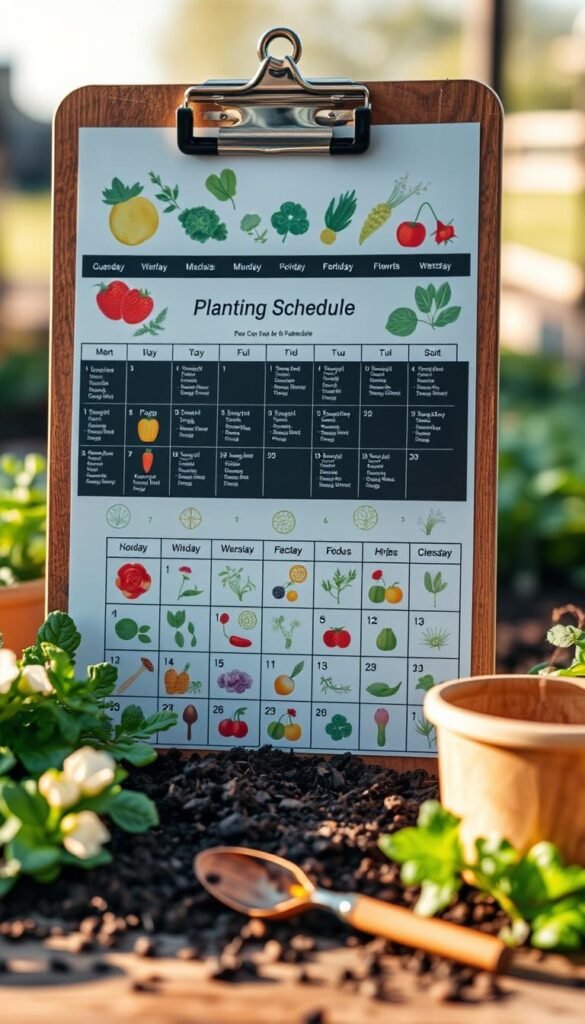
Perfect timing turns sporadic harvests into a steady supply of fresh produce. By aligning your planting dates with nature’s calendar, you’ll squeeze three growing seasons from one year while keeping soil active and healthy.
Timing Your Plantings Across Seasons
Start cabbage family seeds indoors 6-8 weeks before fall’s first frost. Transplant seedlings 4 weeks later, spacing them 24-36 inches apart. This gives them time to mature before temperatures drop sharply.
Try relay planting: sow spinach where summer tomatoes fade. As you pull spent plants, new crops inherit warmed soil and residual nutrients. This method keeps your plot productive without overcrowding.
For spring, choose cold-hardy varieties like kale or radishes. In summer, switch to heat-loving peppers. Come fall, plant quick-growing arugula 8 weeks before frost. Staggering plantings this way ensures continuous harvests.
New to seed starting? Our beginner’s checklist simplifies indoor sowing. Match maturity dates to your climate—early tomatoes need 60 days, while winter squash requires 100+ frost-free days.
Rotate planting zones annually. After harvesting spring peas, replant that space with bush beans. This prevents soil exhaustion and keeps pests guessing. You’ll spend less time troubleshooting and more time enjoying crisp veggies.
Integrating Companion Planting and Soil Enrichment
Boost your plot’s potential by pairing plants that work together naturally. When you combine smart partnerships with rich earth care, you create a thriving ecosystem where every element supports growth. Let’s explore how to build these connections for healthier yields.
Choosing the Right Plant Partners
Some plants act like bodyguards for their neighbors. Marigolds, for example, release chemicals that repel harmful nematodes by up to 75%. Plant them near tomatoes to shield roots from pests. Basil improves tomato flavor while deterring flies—a win-win partnership.
The “Three Sisters” method shows how corn, beans, and squash support each other. Corn stalks give beans vertical space to climb, beans add nitrogen to feed corn, and squash leaves shade soil to retain moisture. These collaborations reduce weeding and watering needs.
Organic Amendments and Composting Tips
Healthy soil starts with organic matter. Mix finished compost into beds to improve drainage and nutrient levels. For a quick boost, brew compost tea—it’s packed with microbes that help roots absorb minerals. Building an organic soil foundation ensures plants get balanced nutrition without synthetic additives.
Try vermicomposting if space is limited. Worms transform kitchen scraps into rich castings that act as a natural fertilizer. Combine this with clover cover crops to add 4-6 tons of organic matter per acre. Your earth becomes a self-sustaining system that grows stronger each season.
By blending smart plant pairs with soil-building techniques, you’ll see fewer pests and bigger harvests. It’s nature’s smarter way to grow—and your ticket to effortless abundance.






